Ali Görçin
Design and Evaluation of Neural Network-Based Receiver Architectures for Reliable Communication
Mar 26, 2025

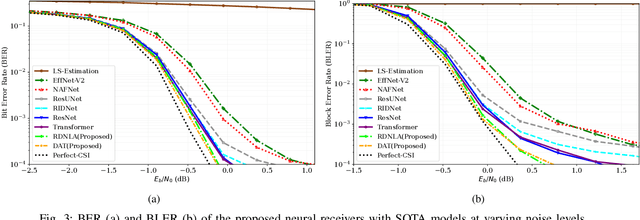
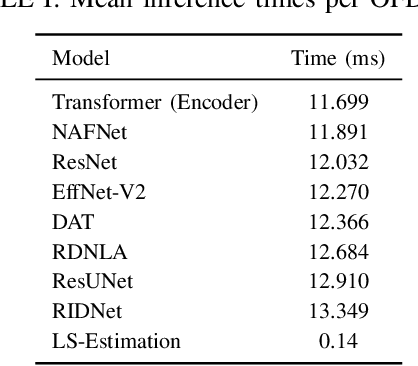
Abstract:Neural network-based receivers leverage deep learning to optimize signal detection and decoding, significantly improving bit-error rate (BER) and block-error rate (BLER) in challenging environments. This study evaluates various architectures and compares their BER and BLER performance across different noise levels. Two novel models, the Dual Attention Transformer (DAT) and the Residual Dual Non-Local Attention Network (RDNLA), integrate self-attention and residual learning to enhance signal reconstruction. These models bypass conventional channel estimation and equalization by directly predicting log-likelihood ratios (LLRs) from received signals, with noise variance as an additional input. Simulations show that DAT and RDNLA outperform traditional and other neural receiver models under varying signal-to-noise ratios (SNR), while their computational efficiency supports their feasibility for next-generation communication systems.
RIS Optimization Algorithms for Urban Wireless Scenarios in Sionna RT
Jan 10, 2025Abstract:This paper evaluates the performance of reconfigurable intelligent surface (RIS) optimization algorithms, which utilize channel estimation methods, in ray tracing (RT) simulations within urban digital twin environments. Beyond Sionna's native capabilities, we implement and benchmark additional RIS optimization algorithms based on channel estimation, enabling an evaluation of RIS strategies under various deployment conditions. Coverage maps for RIS-assisted communication systems are generated through the integration of Sionna's RT simulations. Moreover, real-world experimentation underscores the necessity of validating algorithms in near-realistic simulation environments, as minor variations in measurement setups can significantly affect performance.
RF Chain-Free mmWave Transmission: Modeling and Experimental Verification
May 03, 2024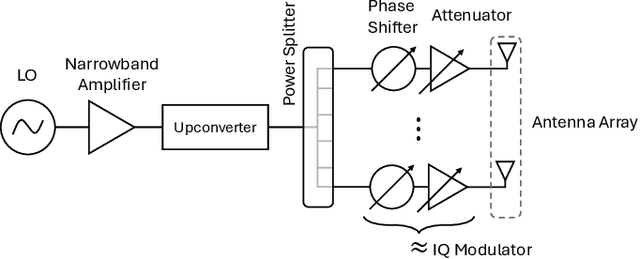
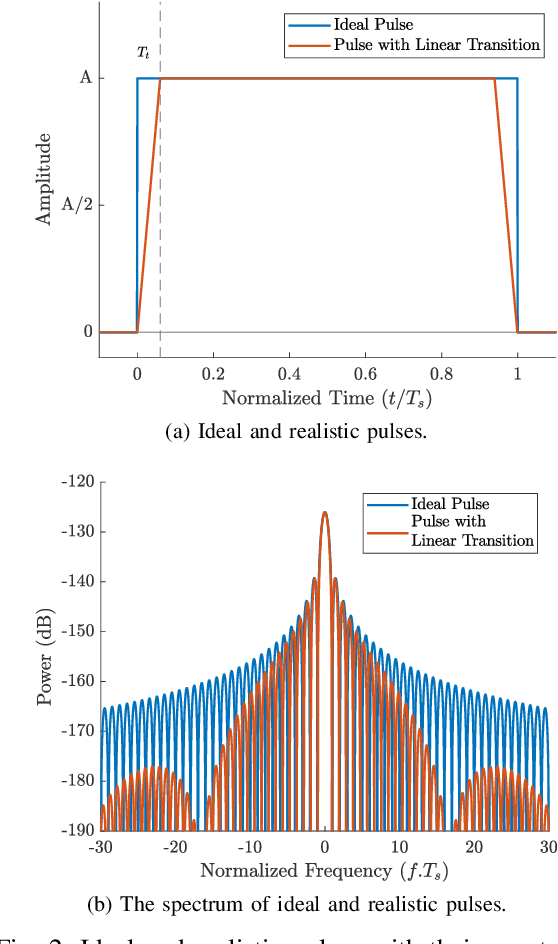
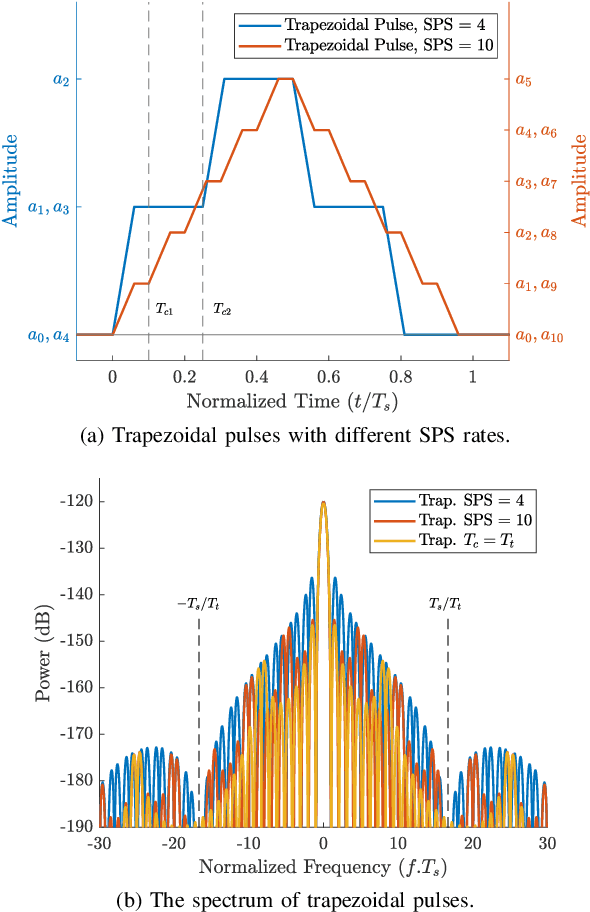
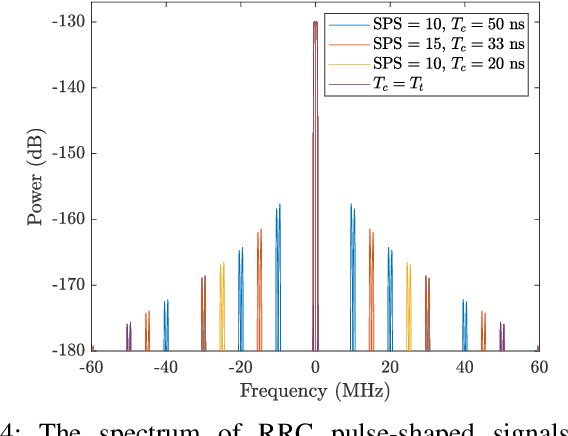
Abstract:The utilization of millimeter wave frequency bands is expected to become prevalent in the following communication systems. However, generating and transmitting communication signals over these frequencies is not as straightforward as in sub-6 GHz frequencies due to complex transceiver structures. As an alternative to conventional transmitter architectures, this paper investigates the implementation of time-modulated arrays to effectively modulate and transmit high-quality communication signals at millimeter wave frequencies. By exploiting the array structures and analog beamformers, which are the fundamental components of millimeter wave transmitters, secure and low-cost transmission can be achieved. Though, harmonics of theoretically infinite bandwidth arise as a fundamental problem in this approach. Thus, this paper presents a frequency analysis tool for the time-modulated arrays with hardware impairments and shows how controlling the sampling period can reduce the harmonics. Furthermore, the derived results are experimentally verified at 25 GHz with two important remarks. First, the phase error of received signals can be reduced by 32% using the proposed architecture. Second, the harmonics can be significantly suppressed by the correct choice of sampling period for the given hardware.
Channel Estimation Using RIDNet Assisted OMP for Hybrid-field THz Massive MIMO Systems
Aug 31, 2023Abstract:The terahertz (THz) band radio access with larger available bandwidth is anticipated to provide higher capacities for next-generation wireless communication systems. However, higher path loss at THz frequencies significantly limits the wireless communication range. Massive multiple-input multiple-output (mMIMO) is an attractive technology to increase the Rayleigh distance by generating higher gain beams using low wavelength and highly directive antenna array aperture. In addition, both far-field and near-field components of the antenna system should be considered for modelling THz electromagnetic propagation, where the channel estimation for this environment becomes a challenging task. This paper proposes a novel channel estimation method using a recursive information distillation network (RIDNet) together with orthogonal matching pursuit (OMP) for hybrid-field THz mMIMO channels, including both far-field and near-field components. The simulation experiments are performed using the ray-tracing tool. The results indicate that the proposed RIDNet-based method consistently provides lower channel estimation errors compared to the conventional OMP algorithm for all signal-to-noise ratio (SNR) regimes, and the performance gap becomes higher at low SNR regimes. Furthermore, the results imply that the same error performance of the OMP can be achieved by the RIDNet-based method using a lower number of RF chains and pilot symbols.
Rapid CNN-Assisted Iterative RIS Element Configuration
Jul 21, 2023Abstract:Reconfigurable Intelligent Surfaces (RISs) are becoming one of the fundamental building blocks of next-generation wireless communication systems. To that end, RIS phase configuration optimization is an important issue, where finding the most suitable configuration becomes a challenging and resource-consuming task, especially as the number of RIS elements increases. Since exhaustive search is not practical, iterative algorithms are utilized to determine the RIS configuration by sequentially considering all RIS elements, where the best-performing phase shift configuration is obtained for each element. However, each configuration attempt requires receiver performance feedback, leading to higher delay and signaling overhead. Thus, in this paper, a convolutional neural network (CNN) based solution is formulated to rapidly find the phase configurations of the RIS elements. The simulation results for a RIS with $40\times40$ elements imply that the proposed algorithm reduces the number of steps dramatically e.g., from 3200 to 160 for the particular setup. Furthermore, such improvement in complexity is achieved with a slight degradation in performance.
RIDNet Assisted cGAN Based Channel Estimation for One Bit ADC mmWave MIMO Systems
Jun 15, 2023Abstract:The estimation of millimeter wave (mmWave) massive multiple input multiple output (MIMO) channels becomes compelling when one-bit analog to digital converters (ADCs) are utilized. Furthermore, as the number of antenna increases, pilot overhead scales up to provide consistent channel estimation, eventually degrading spectral efficiency. This study presents a channel estimation approach that combines a conditional generative adversarial network (cGAN) with a novel blind denoising network with a sparse feature attention mechanism. Performance analysis and simulations show that using a cGAN fused with a feature attention-based denoising neural network significantly enhances the channel estimation performance while requiring less pilot transmission.
Measurement-based Channel Characterization for A2A and A2G Wireless Drone Communication Systems
Jun 14, 2023



Abstract:This paper presents field measurement-based channel characterization for air--to--ground (A2G) and air--to--air (A2A) wireless communication systems using two drones equipped with lightweight software-defined radios. A correlation-based channel sounder is employed such that the transmitting drone broadcasts the sounding waveform with a pseudo-noise sequence and the receiving drone captures the sounding waveform together with the location information for the post-processing analysis. The path loss results demonstrate that the measurement and flat-earth two-ray results have similar trends for A2G while the measurement and free space path loss are similar to each other for A2A. The time delays between the direct path and multipath components are widely spread for A2A while the multipath components are mostly concentrated around the direct path for A2G generating a more challenging communication environment. We observe that the reflections from several buildings having metal roofs and claddings on the measurement site cause sudden peaks in the root-mean-square delay spread. The results indicate that the A2A channel has better characteristics than the A2G under similar mobility conditions.
Measurement-Based Modeling of Short Range Terahertz Channels and Their Capacity Analysis
Jun 14, 2023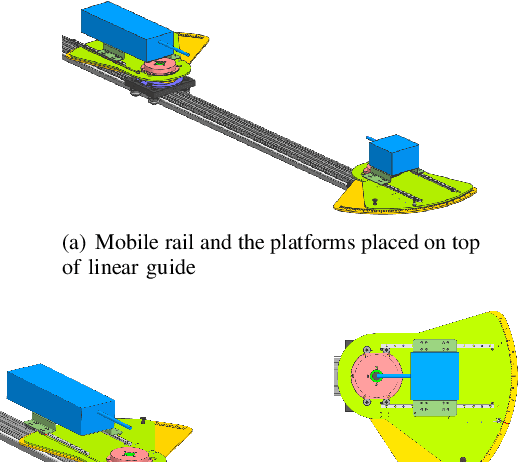
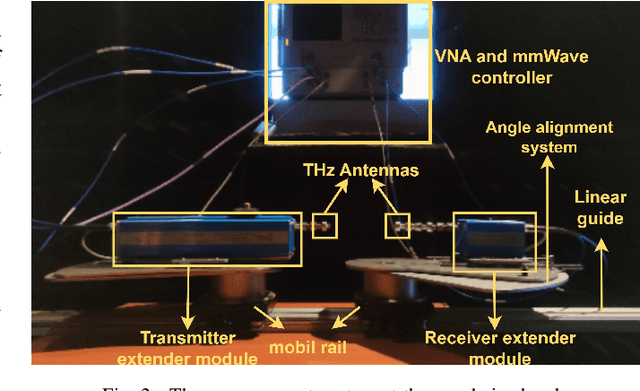
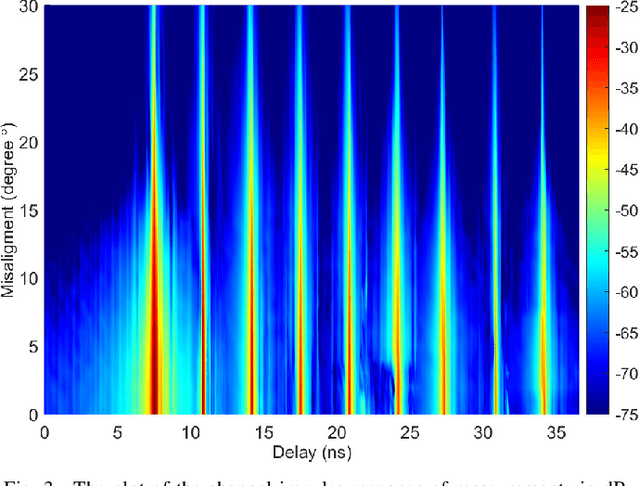
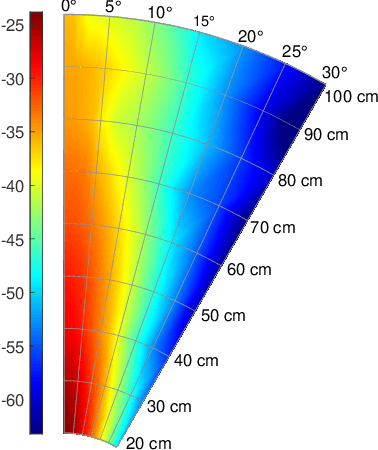
Abstract:In this work, extensive propagation characteristics of short range 240 to 300 GHz terahertz (THz) channels are mapped based on a measurement campaign conducted utilizing a novel, task specific measurement system. The measurement system allows collecting measurements from different distances and orientations in a very fine grained resolution, which is a particular issue in achieving realistic THz channel estimation. After the accurate measurement results are obtained, they are investigated in terms of channel impulse and channel frequency response. Furthermore, the fading channel amplitude histograms are modeled with the Gamma mixture model (GMM). The expectation-maximization (EM) algorithm is utilized to determine the corresponding mixture parameters. Also, to demonstrate the flexibility of the GMM, the Dirichlet process Gamma mixture model (DPGMM) is utilized in cases where the EM algorithm fails to represent histograms. Moreover, the suitability of the GMM is evaluated utilizing Kolmogorov Smirnov tests. Results verify that the GMMs can simulate the fading channel of micro-scale THz wireless communication in a realistic way, providing important implications regarding the achievable capacity in these channels. Finally, the average channel capacity of each link is evaluated using the probability density function of GMMs to gain deeper insight into the potential of micro-scale THz communications.
Experimental Assessment of Misalignment Effects in Terahertz Communications
May 23, 2023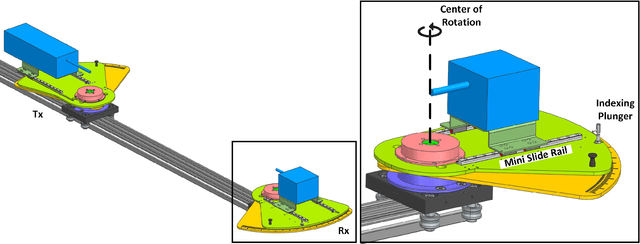
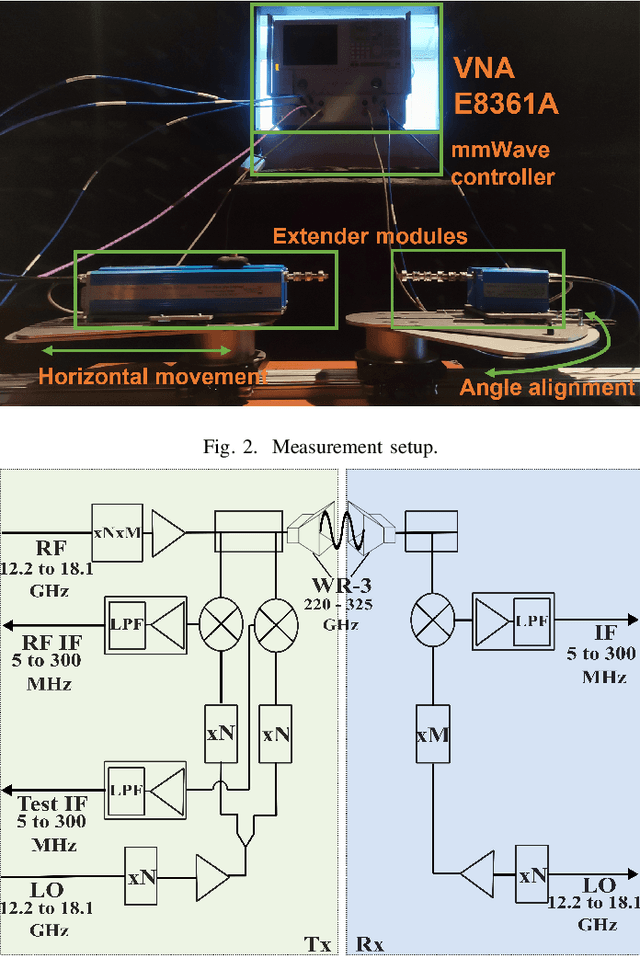
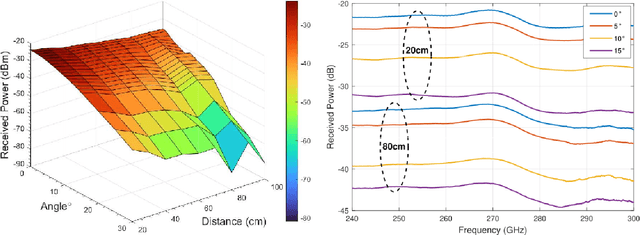
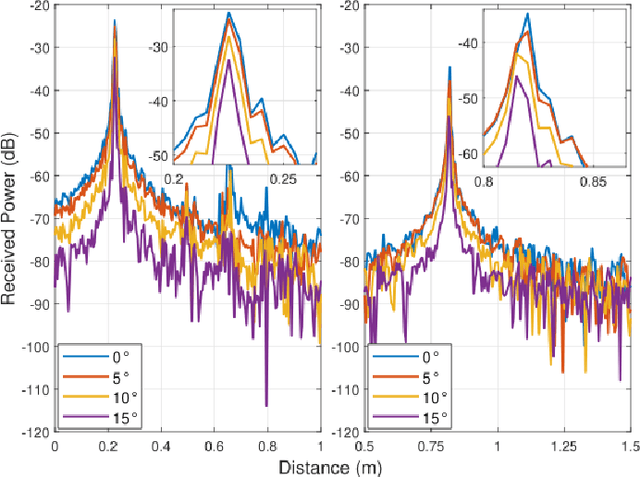
Abstract:Terahertz (THz) frequencies are important for next generation wireless systems due to the advantages in terms of large available bandwidths. On the other hand, the limited range due to high attenuation in these frequencies can be overcome via densely installed heterogeneous networks also utilizing UAVs in a three-dimensional hyperspace. Yet, THz communications rely on precise beam alignment, if not handled properly results in low signal strength at the receiver which impacts THz signals more than conventional ones. This work focuses on the importance of precise alignment in THz communication systems and the significant effect of proper alignment is validated through comprehensive measurements conducted through a state-of-the-art measurement setup, which enables accurate data collection between 240 GHz to 300 GHz at varying angles and distances in an anechoic chamber eliminating reflections. By analyzing the channel frequency and impulse responses of these extensive and particular measurements, this study provides the first quantifiable results in terms of measuring the effects of beam misalignment in THz frequencies.
Measurement-based Characterization of Physical Layer Security for RIS-assisted Wireless Systems
Dec 14, 2022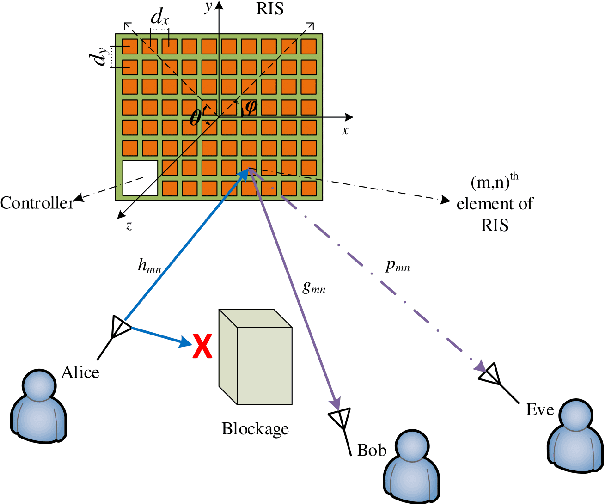
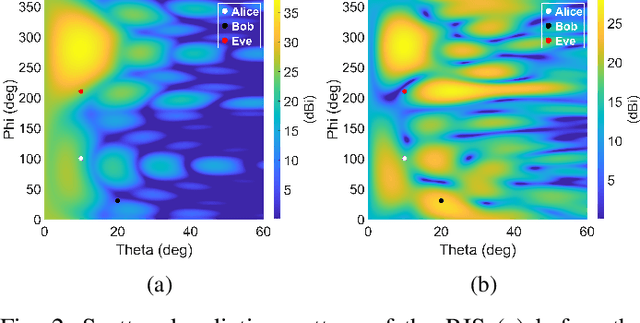
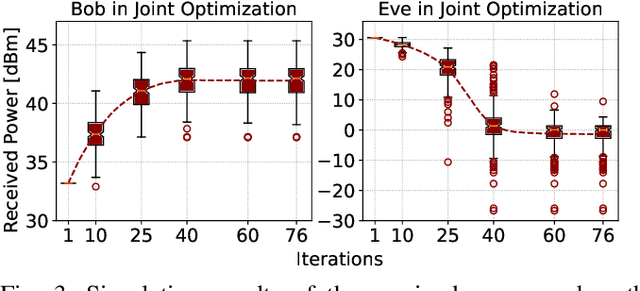
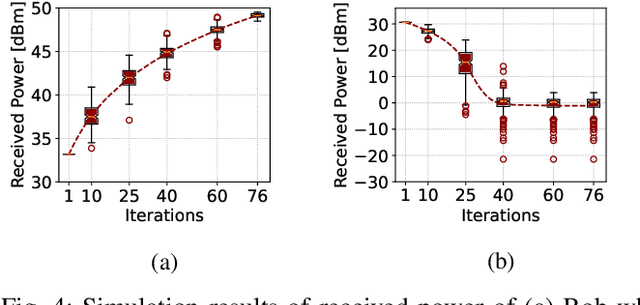
Abstract:There have been recently many studies demonstrating that the performance of wireless communication systems can be significantly improved by a reconfigurable intelligent surface (RIS), which is an attractive technology due to its low power requirement and low complexity. This paper presents a measurement-based characterization of RISs for providing physical layer security, where the transmitter (Alice), the intended user (Bob), and the eavesdropper (Eve) are deployed in an indoor environment. Each user is equipped with a software-defined radio connected to a horn antenna. The phase shifts of reflecting elements are software controlled to collaboratively determine the amount of received signal power at the locations of Bob and Eve in such a way that the secrecy capacity is aimed to be maximized. An iterative method is utilized to configure a Greenerwave RIS prototype consisting of 76 passive reflecting elements. Computer simulation and measurement results demonstrate that an RIS can be an effective tool to significantly increase the secrecy capacity between Bob and Eve.
 Add to Chrome
Add to Chrome Add to Firefox
Add to Firefox Add to Edge
Add to Edge